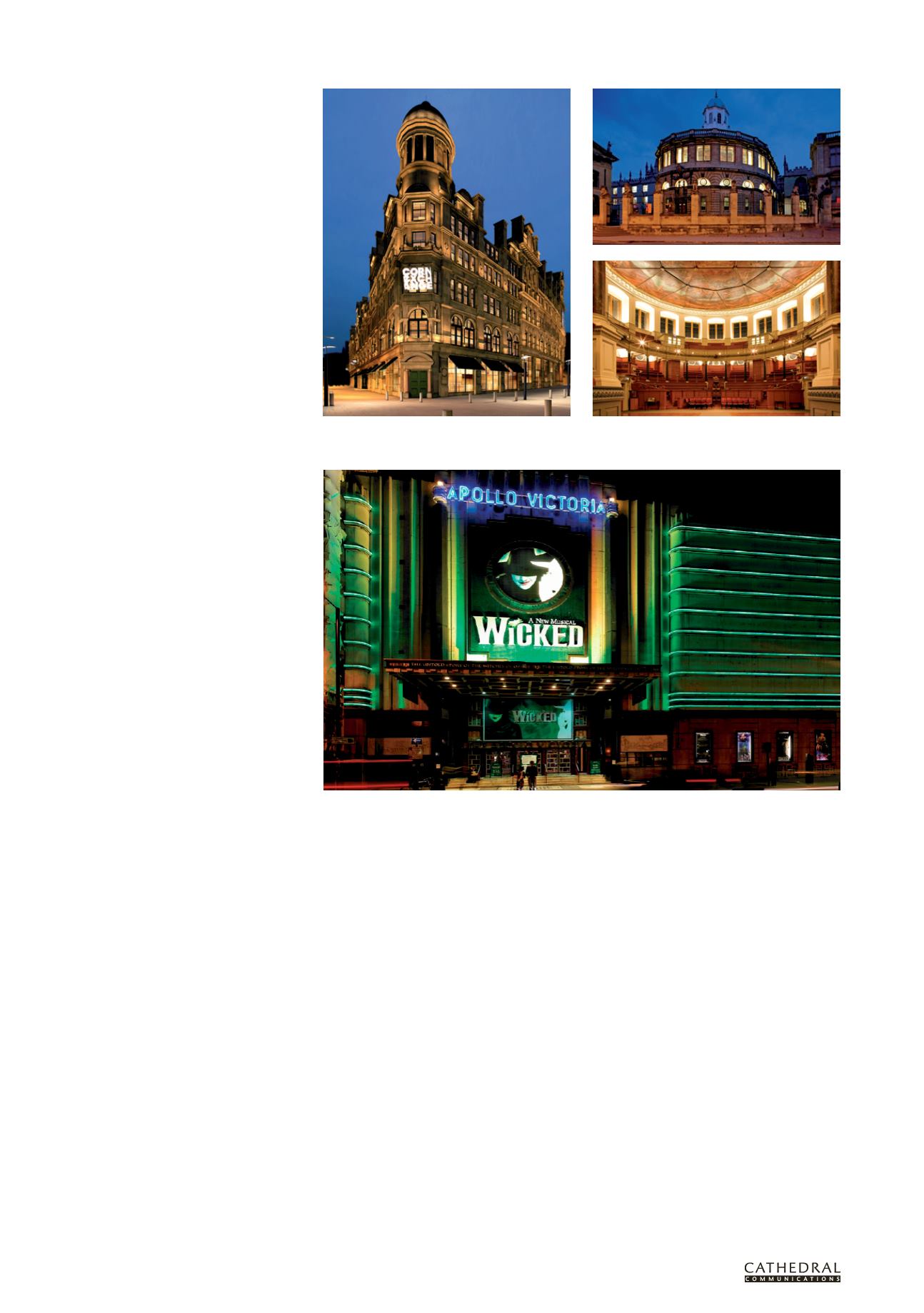

1 5 2
T H E B U I L D I N G C O N S E R VAT I O N D I R E C T O R Y 2 0 1 6
T W E N T Y T H I R D E D I T I O N
4.2
SERV I CES & TREATMENT :
HEAT I NG & L I GHT I NG SERV I CES
Ernest Wamsley Lewis’s original 1930s lighting scheme for the Apollo Victoria, London was only recently made
possible by the development of LED lighting technology. The new scheme uses the original housing slots for the
first time.
A computer-generated image (CGI) showing proposals
for the illumination of the old Corn Exchange
building, Manchester (Image: Hoare Lea CGI)
At the Sheldonian Theatre, Oxford, townscape
interest is achieved by leaving the exterior walls dark
and lighting the interior instead.
produced to address these issues, and establish
limits and measures to control obtrusive light.
To minimise and mitigate potential
adverse obtrusive light effects on the
environment, the following measures should
be considered at an early design stage:
• flat-glass light distribution: this
eliminates direct upwards light, the
primary contributor to sky glow
• minimal column heights: this can reduce the
light footprint and any resulting overspill
(however, shorter columns invariably lead
to an increased number of lighting points)
• switching off or dimming unnecessary
lighting during unoccupied hours
(subject to health and safety approval)
• light-controlling shields: these provide a
cut-off to the light distribution; within a
good design scheme they are a last resort
and are usually applied post-installation
• sympathetic and sensitive design
in relation to night-time lit effect,
luminaire finish, positioning, fixing
methods and the overall appearance
of the installation during daytime
• planting and retention of trees on the
site: trees provide a natural method of
screening; the best effects are achieved
with dense, evergreen species.
TECHNOLOGICAL ADVANCES
Advances in the manufacture of light
fittings and light-source technology have
resulted in the production of lighting ranges
which are suitable for the most sensitive
environments. For example, LEDs have
the benefit of putting light only where it
is wanted. Similarly, research has shown
that our visual acuity is improved when
using white light in lower lighting levels,
resulting in a reduction of illuminance
levels where specific sources are selected.
Such advances allow for visibly lower
levels of obtrusive light. Improvements are
constantly being made in the control of light
and their implementation should see a steady
reduction of obtrusive light.
MASTERPLANNING
Recent technological advances are perhaps
most evident when considering the process of
designing a lighting masterplan. Here we have
to use everything modern technology has to
offer, while carefully considering a range of
different building styles and uses.
Our towns and cities grow organically
and external lighting provision grows with
them. No single style of lighting predominates
– different styles, fashions and techniques
provide interest and variety as a city evolves.
While designing the external lighting
masterplan for a development in Oxford,
Hoare Lea studied existing lighting in
the city. By taking cues from previous
installations it was possible to ensure
that the new installation was comfortably
integrated into the city’s nightscape.
Mounting methods, colour temperature and
illuminance levels were all considered, so
that while modern, efficient luminaires were
installed, the feel and aesthetic is very much
an extension of the city.
MINIMAL, TARGETED LIGHTING
The future of the nightscape is positive as
luminaires become smaller and more efficient,
guidance becomes more focussed and the
night sky is cleared of the ‘sky glow’ still
common in many towns and cities. Heritage
buildings play a vital part in showing the
public what can be achieved when minimal
light is targeted in a considered way.
Whether or not to light a building at
night is itself a significant question, especially
in terms of sustainability and energy
consumption. However, public visibility is
increasingly important for heritage sites. For
example, historic buildings which are open
to the public typically need to attract visitors
throughout the year in order to maintain
their balance sheets – so a night time street
presence is important. The key is to light with
the minimum number of fittings, the lowest
energy use, the most efficient maintenance
regime, and with luminaires which have little
or no aesthetic impact on the building during
the day. Recent advances in technology have
finally brought these objectives within reach.
Further Information
The Institution of Lighting Professionals,
Guidance Notes for the Reduction of
Obtrusive Light
, 2011
(www.theilp.org.uk/documents/obtrusive-light)
Bat Conservation Trust,
Artificial Lighting
and Wildlife – Interim Guidance:
Recommendations to help minimise the
impact of artificial lighting
, 2014
(www.bats.org.uk/publications.php)
SIMON DOVE
is an Associate Lighting
Designer with Hoare Lea Lighting (see
page 149). His specialist area is heritage
and conservation and his work includes
lighting schemes for The Cumberland
Gallery at Hampton Court Palace; The
Sheldonian Theatre, Oxford; and the
King’s Bath, at the Roman Baths and
Pump Room complex in Bath.
















